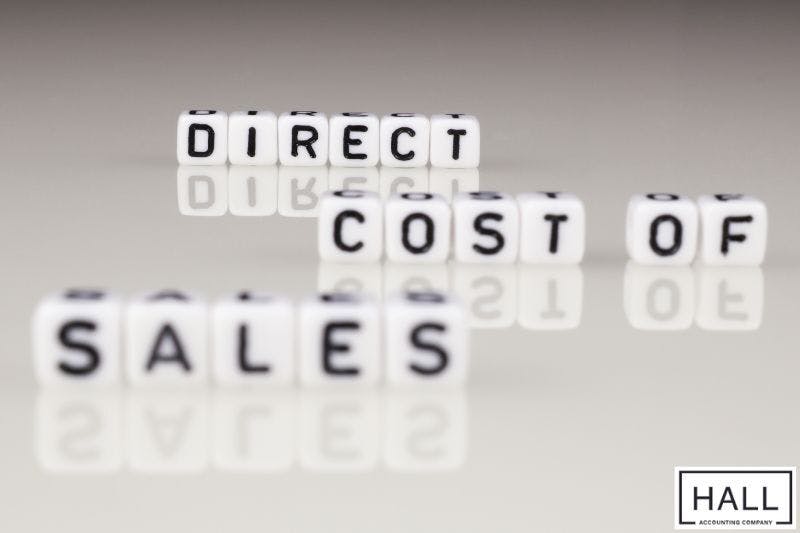
Cost of Sales and Cost of Goods Sold are two accounting terms that are often used interchangeably. However, the correct usage of these words depends on the type of business you own and the distinctions can be important for SBOs when making key business decisions.
In this article, we aim to understand Cost of Sales vs. Cost of Goods Sold by examining the key differences and how they affect business bookkeeping.
If you’re a product and services business, your challenges are more complicated. You have to understand both concepts and how to reflect them in your day-to-day bookkeeping processes. Hall Accounting Company wants to help you navigate easily through the challenges this might present. We provide bookkeeping services as well as taxation services for SMEs. Let’s talk about how we can help your SME thrive.
Definition of Cost of Sales
Cost of Sales (COS) encompasses all costs directly associated with the production of goods or services sold by a company. It is a much broader term than Cost of Good Sold, and is also used by companies that offer services. In service businesses it includes not just direct costs but also a wide range of operating expenses that can be attributed directly to the provision of the service. These expenses may be termed direct expenses and indirect expenses.
Summary of what qualifies as COS
Direct Expenses | Indirect Expenses |
The costs directly related to providing the service | The indirect costs associated with the service |
Labor Costs: Include the wages and salaries of employees directly involved in providing the service. | Administrative expenses: These are costs that support the service being rendered but are not directly involved. This can be the salary of an assistant or accounting fees. |
Materials Used: While not as extensive as in the production of goods, these are consumables used in the provision of a service. E.g. Cleaning supplies, gardening supplies, conference supplies. | Utilities: Costs for electricity, water, and internet that are essential for maintaining the business premises but are not directly allocable to specific services. |
Subcontractor fees: Fees paid to third-party suppliers directly linked to the provision of the service. | Rent and taxes: The cost of leasing or maintaining office spaces. This can even be an event space that is used for multiple clients. |
Travel and transport costs: Direct costs incurred to reach the client’s location or transport materials or employees necessary to deliver the service. | Depreciation: This includes the depreciation of capital assets like buildings, non-direct equipment, and furniture that contribute to creating an environment for providing services. |
Equipment costs: Costs of using equipment that are directly involved in service provision can be included, especially if the equipment is rented or leased specifically for client projects (e.g., construction tools, audio-visual equipment for event management). | Marketing Costs: The cost of marketing and advertising the business services to the public. |
To take this one step further, these expenses can also be separated into fixed costs and variable costs.
Fixed costs: Costs that do not change regardless of business activity or the products sold
Variable costs: Costs that change in direct proportion to the activity of the business or the products sold
General Ledger account for COS

Cost of sales is tracked in specific general ledger accounts under the expenses category. The expenses are initially recorded in asset accounts such as prepaid expenses for services or raw materials for goods. This is done through journal entries that debit the cost of sales and credit the asset account.
Financial Statement Inclusion
Cost of sales is a prominent figure in the income statements of all companies. It is subtracted from sales revenue, to get the gross profit figure.
Sales - Cost of Sales = Gross Profit
As a business you are aiming for a high revenue figure and a lower cost of sales figure because it makes the business more profitable.
The effect of service delivery on COS
Like inventory levels affect COGS, the volume and efficiency of service delivery can impact the cost of sales. Efficient management of service delivery costs (e.g., optimal scheduling, and effective use of materials and labor) leads to better profitability. This can be very challenging for service-orientated businesses
Practical Example

Imagine a company, MediTech Inc, provides tech support for hospitals. It starts the year with $20,000 worth of prepaid service costs. Throughout the year, it incurs $100,000 in direct labor costs and $30,000 in other direct service costs. If at year-end, the remaining prepaid service costs are $10,000. Cost of sales would be $140,000 according to the calculation:
Cost of Sales = $20,000 + $100,000 + $30,000 − $10,000 = $140,000
Depending on the Sales revenue obtained from the services they have provided this business would need to closely monitor the cost of sales.
There are a number of metrics that will help you steer your business in the right direction, such as gross profit margin, break-even analysis and markup on cost. These metrics provide you with valuable insights for determining your pricing strategy and also putting measures in place to manage the cost of production or services.
These don’t have to just be numbers on a page, our experienced team can help you turn metrics into sustainable business decisions to increase the financial health of your business. Call us today and let’s get to work.
Definition of Cost of Goods Sold
Cost of Goods Sold (COGS) is an accounting term that represents the direct costs attributable to the production of goods sold by a company. These are direct costs involved in production such as raw materials, labor costs, shipping costs, and production costs. It can also include the indirect costs of production such as maintenance of machinery.
These direct costs are related to the revenue generated from products sold and therefore give a good indication of the business’s financial health, because it allows you to measure production efficiency and your pricing strategy.
Summary of what qualifies as COGS
Direct Materials | Direct Labor | Overhead Costs |
There are the raw materials that are directly used in the production of the goods | These are the wages of the employees directly involved in the production process | Indirect costs related to production which may include utilities for the factory, maintenance of equipment, and depreciation of machinery. |
General Ledger account for COGS
Adhering to accounting principles is important for the standardization of financial information across business sectors. COGs is recorded in a specific general ledger account under the expenses category.
Throughout the accounting period purchases of direct costs related to material and labor are recorded in asset accounts such as inventory or production labor. When goods are sold the cost is then transferred out of these accounts to the COGS expense account.
Further reading: Is Cost of Goods Sold a Debit or a Credit? Help for SBOs.
Financial Statement Inclusion

COGS appears predominantly in the company’s income statement where it is subtracted from revenue to get the gross profit.
Revenue - Cost of Goods Sold = Gross Profit
This is a critical figure that indicates how effectively the company is producing and selling its products. A lower COGS relative to the revenue amount indicates higher profitability.
COGS is also indirectly reflected in the company’s statement of cash flow because it affects the inventory levels.
The effect of inventory levels on COGS
Inventory levels play a critical role in determining COGS and therefore, the management of inventory (how much is bought, held and then sold) is crucial for the final COGS amount on the income statement.
How inventory levels affect COGS lies in elements of the COGS calculation, which is:
COGS = Opening inventory + purchases - closing inventory
Higher closing inventory
If a company ends the period with a higher amount of inventory than it started with, the closing inventory is higher. This increase offsets the total amount added to COGS through purchases, leading to a lower COGS. A lower COGS can mean higher gross profits, assuming sales remain consistent.
Lower closing inventory
Conversely, if a company has less inventory at the end of the period (either due to increased sales or decreased purchases), the closing inventory decreases. This leads to a higher COGS, reducing gross profits. This situation could indicate either good sales performance or potential issues with stock replenishment.
Practical Example

Let’s say a business that manufactures shoes for dogs, Paws For All, starts the year with $10,000 worth of inventory. They purchase $50,000 of additional stock throughout the year, and the closing inventory is $15,000. The COGS amount is $45,000. But suppose the closing inventory reduces to $5,000 due to a surge in interest in dog shoes.
The reduced inventory leads to a higher COGS figure and this indicates that more stock was converted to sales.
Managing a hybrid business
Businesses that offer both goods and services have a unique accounting challenge because they need to manage both Cost of Goods Sold and Cost of Sales. At the start of this article we mentioned that we were ready to discuss your unique needs. That’s still the case, because we want to see your business thrive as you do what you love. You can schedule a consultation now (It’s free) or you can continue reading our tips.
Here are just three points for handling this unique situation.
Separate tracking of COGS and COS
Maintaining separate accounts is key so that the costs associated with goods and the costs associated with services are not mixed. This will give more accurate figures when analyzing how each segment of the business is performing.
Allocation of mixed costs
Some costs may overlap for the production of goods and the provision of services. You should aim to record these costs in the same manner consistently.
Inventory management for COGS and service costing for COS
Businesses must track the cost of inventory purchases, manufacturing costs, and related expenses that are directly part of COGS. For services, direct costs like labor, materials specifically used in delivering a service, and any direct overheads should be accounted for in COS. Indirect costs shared between goods and services need to be allocated based on an equitable basis.
Furthermore, the proper classification of COGS and COS is important for tax purposes, as there are different rules that can apply to each.
Conclusion
We’ve come to the end of our short guide on COS and COGS. If you’re interested in learning more about these topics, you are welcome to read our ‘By Numbers’ blog, which provides helpful accounting and taxation advice for SMEs.
We trust that this guide has given you the basic information you were searching for, however, if you would like to discuss your bookkeeping and taxation needs with a professional, don’t hesitate to contact us directly and set up a FREE consultation. We also offer fractional CFO services for small businesses and startups.
Find out more about fractional CFO services